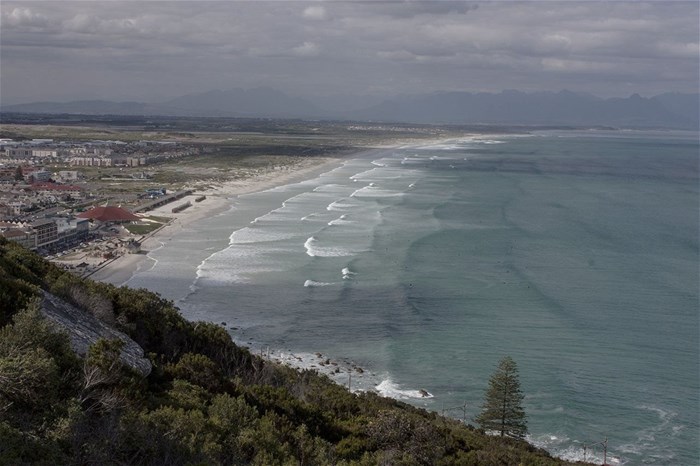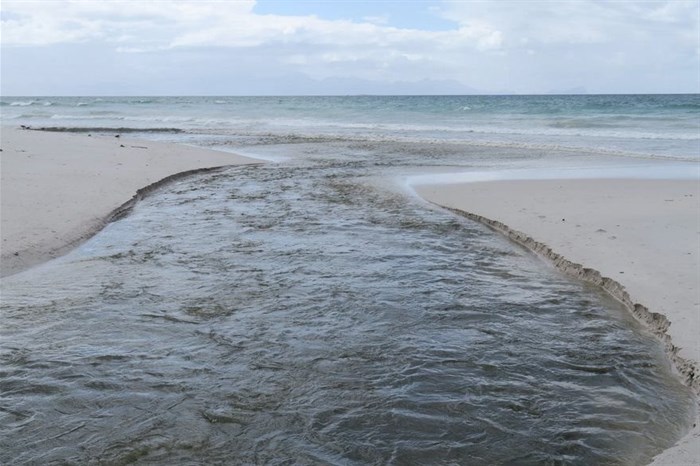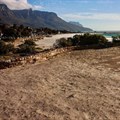Most of Cape Town’s sewage treatment works are failing, including the city’s largest one which releases effluent straight into the sea.

More than 200-million litres of untreated or partially treated sewage is released into False Bay daily. Photos: Steve Kretzmann / GroundUp
- Of Cape Town’s 23 sewage treatment works, 15 fail to treat the sewage to acceptable standards before releasing it into the environment.
- As a result, at least 382-million litres of untreated or partially treated sewage is released into Cape Town’s rivers and oceans, 216-million litres of which goes into False Bay every day.
- Coastal water quality from Strandfontein to Gordon’s Bay has been labelled ‘poor’ for years, and scientific studies show pharmaceutical and chemical compounds released in sewage are accumulating in the marine foodchain.
While the City of Cape Town is looking at ways to stop pumping untreated sewage off the Atlantic seaboard, its largest sewage treatment works, situated near Strandfontein, is polluting False Bay by failing to treat sewage properly.
The Cape Flats wastewater treatment works (WWTW) treats at least 114-million litres of sewage per day, according to the 2022 Green Drop Report released by the Department of Water and Sanitation (DWS).
Yet, data on the DWS Integrated Regulatory Information System (IRIS), to which all municipalities have to post monthly effluent test results from their sewage treatment works, shows the Cape Flats WWTW has failed to treat sewage to minimum standards for the past six years. It releases this effluent into the bay at Sonwabe Beach via a channel that runs beneath Baden Powell Drive.
The effluent is supposed to comply with minimum standards set by the DWS before being released into the environment. These include microbiological compliance (the amount of faecal bacteria such as E. coli) and chemical compliance (chemical oxygen demand, presence of orthophosphates, nitrates, nitrites, and ammonia). The average microbiological compliance at the Cape Flats WWTW for 2023 was 0%, with a chemical compliance of 43%. The sewage works scored 2% for microbiological compliance in 2022, and had 0% compliance in 2021 and 2020. Its highest microbiological compliance score in the last six years was 20% in 2018. The highest chemical compliance score over the same period was 43% in 2023.

This is the outlet from the Cape Flats wastewater treatment works into False Bay.
With a 200-million litre per day capacity, the Cape Flats WWTW is by far the largest sewage works in Cape Town, but it is not the only one that is failing. Data on IRIS shows that last year 15 of Cape Town’s 23 sewage treatment works failed to meet microbiological or chemical compliance, or both. This does not include the marine outfalls at Green Point, Sea Point, and Hout Bay which do not treat the more than 32-million litres of sewage they pump into the sea daily. The 2024 monthly compliance results for Cape Town’s sewage treatment works do not appear to have been loaded onto IRIS yet.
Thus, read in conjunction with the latest Green Drop Report, during 2023 more than 382-million litres of partially treated or untreated sewage were released every day into the rivers, estuaries, and oceans in and around Cape Town.
Of this, 216-million litres flowed into False Bay every day, released either directly into the ocean, or via rivers such as the Eerste River. The rest flowed into the Atlantic on the western seaboard.
Coastal water quality
The currently available coastal water quality reports published by the City shows results from weekly samples at 14 popular recreational areas in False Bay taken between 3 October and 30 January. These were analysed by an independent laboratory as part of a 12-month research programme. The results show high levels of enterococci (a bacteria indicating sewage pollution) at various False Bay sites on numerous occasions.
Separately, the City’s scientific services tests water quality at 99 coastal sites every two weeks (45 sites on the Atlantic coast and 54 sites in False Bay), but in March last year, then Acting Mayco Member for Water and Sanitation Siseko Mbandezi stated the City’s laboratory was unable to test for enterococci since at least November 2022 “due to delays and quality challenges experienced with chemicals and consumables received”.
This appears to have begun to be resolved in November 2023 when the City started presenting enterococci results again, but enterococci data for many sites are still not available. Scientific services have, however, continued to test for E. coli as a faecal pollution indicator, although World Health Organisation (WHO) guidelines cast doubt on E. coli being a meaningful indicator for coastal water quality.
As a result of scientific services’ year-long gap in enterococci analysis, combined with the independent research programme at 30 recreational sites from which samples are tested at an independent laboratory, along with the Blue Flag programme’s monthly testing at 11 selected beaches, the City’s presentation of its water quality results on its website has changed a number of times over the last three months.

This is the Cape Flats wastewater treatment works.
Previously, the City presented a 365-day rolling average for water quality at all 99 testing sites dating back to 2018, with sites graded as “poor”, “sufficient”, “good”, or “excellent”. The last such set of graded results downloaded by GroundUp in November 2023 shows chronically “poor” water quality at all 27 testing False Bay sites situated between Mnandi Beach and Gordon’s Bay. Strandfontein beach has been “sufficient” since 2019, except for being rated “poor” in 2022.
As studies have shown the predominant current in False Bay is clockwise, effluent released from the Cape Flats WWTW might be expected to move eastwards along the coast from Strandfontein toward Mnandi and on toward Gordon’s Bay. In line with this, the Cape Flats WWTW is mentioned as a likely pollution source in the City’s 2020 Know Your Coast report.
Forever chemicals
In addition to faecal bacteria and other disease-causing pathogens, sewage contains pharmaceutical compounds such as antibiotics, pain killers, antiretrovirals, domestic disinfectants, and a group of synthetic compounds know as Per- and polyfluoroalkyl substances (PFAS) which break down very slowly, if at all. Pharmaceuticals, disinfectants, and PFAS are not removed currently from sewage even in the best functioning treatment plants.
Studies by University of the Western Cape Senior Professor Leslie Petrik and Cecilia Y. Ojemaye found many of these compounds are accumulating in the flesh of fish sourced from Kalk Bay harbour. Their study, published in 2019, states: “these chemicals have a high health risk to the pelagic fish, aquatic organisms and to humans who consume them.”
A further study by Petrik and Ojemaye published in 2021, found these persistent chemical compounds are present in seawater and sediment in False Bay, and accumulate up the food chain to seaweed, with higher concentrations found in limpets, mussels, sea urchins, sea snails, and starfish. The most common compound was the widely prescribed anti-inflammatory drug, diclofenac, as well as the antibiotic, sulfamethoxazole, raising fears of it contributing to antibiotic resistance in associated faecal bacteria released in sewage effluent.
City’s response
Mayco Member for Water and Sanitation Zahid Badroodien said the City is “ramping up its investment” in sewage treatment works “in order to address a number of challenges relating to infrastructure, capacity challenges, and treatment processes”.
Badroodien said R1.8-billion is estimated to be spent on extensions and upgrades at WWTWs over the 2023/2024 financial year, increasing to R3-billion for the 2024/25 financial year.
He said at the Cape Flats WWTW in particular, challenges related to the treatment process are being addressed to improve the quality of the effluent. Regarding the other sewage treatment works that release effluent into False Bay, the Macassar WWTW is to have “a significant overhaul” and upgraded from its current 34-million litre per day capacity to 70-million litres per day. But he said it is in an Eskom electricity supply area and impacted by Eskom load shedding. He said Eskom denied a request for it to be excluded from load shedding.
Although the Gordon’s Bay WWTW functions relatively well, it is in an Eskom supply area and “load shedding does cause some issues for it,” he said. Similarly, a request to exclude it from load shedding was denied by Eskom. He said the Bellville WWTW, from which effluent flows into False Bay via the Eerste River, is in the final phase of a refurbishment and treatment process upgrade.
However, no mention was made of plans for the problematic Mitchells Plain WWTW which achieved just 36% for chemical compliance in 2023, releasing at least 26-million litres of partially treated sewage into False Bay per day. Similarly, Scottsdene WWTW was not mentioned. It last achieved a microbiological compliance of 39% and chemical compliance of 32%, releasing 8-million litres of partially treated sewage per day into Bottelary River, which flows to False Bay via the Kuils and then the Eerste rivers.
Similarly, Simon’s Town WWTW, although operating at only 24% of its 5-million litre per day capacity, achieved just 42% for chemical compliance in 2023, releasing 1.2-million litres of partially treated effluent directly into the bay on a daily basis.
But other sewage treatment works are also receiving upgrades and refurbishments. These are Athlone, Potsdam, Wesfleur, and Wildevoelvlei at Kommetjie. These all release effluent either directly or indirectly to the Atlantic ocean on the western seaboard.
This article was originally published on GroundUp.
© 2024 GroundUp. This article is licensed under a Creative Commons Attribution-NoDerivatives 4.0 International License.












